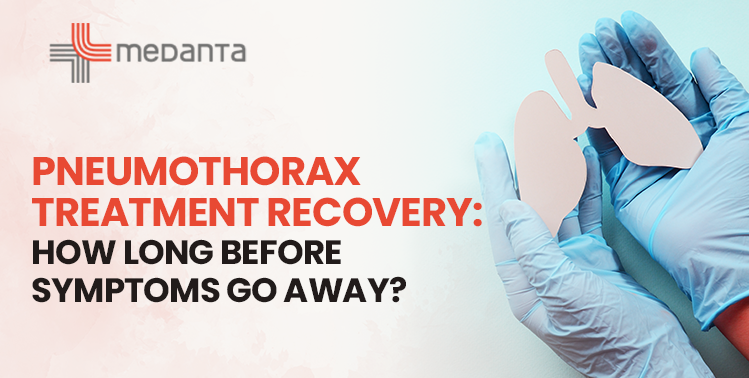CH Baktawar Singh Rd, Medicity, Islampur Colony, Sector 38, Gurugram, Haryana 122001

26 May, 2025
adminWhen you’re dealing with a lung condition like pneumothorax, the physical discomfort can be alarming, but what follows after treatment can also raise a lot of questions. A pneumothorax, or collapsed lung, often comes suddenly and requires medical attention. But what many people want to know is: how long does it take to fully recover? What symptoms might linger, and how can you manage them?
In this Dr Harsh Vardhan Puri blog, we’ll break down what to expect during pneumothorax treatment recovery, explore typical pneumothorax recovery time, and address common symptoms after pneumothorax treatment. Whether you’ve recently experienced a pneumothorax or are supporting someone who has, this guide will help you understand the recovery journey in simple terms.
A pneumothorax occurs when air leaks into the space between your lung and chest wall, causing the lung to collapse either partially or completely. Treatment depends on the severity, ranging from simple observation to medical interventions like chest tube placement or surgery.
Once the initial treatment is done, whether it’s letting the lung heal on its own, removing air with a needle, or undergoing surgery, the focus shifts to recovery. This stage is crucial, not only to ensure the lung re-expands fully but also to prevent complications and recurrence.
Pneumothorax treatment recovery varies from person to person. Several factors influence the healing process:
In general, here’s what recovery might look like:
For small pneumothoraces treated with observation or oxygen therapy, patients may go home the same day or within 24–48 hours. If a chest tube or surgery was required, the hospital stay may last anywhere from a few days to a week.
During this time, doctors monitor the lung’s re-expansion using chest X-rays. You may feel tired, sore, and short of breath during early recovery, especially if you had surgery.
Pain is a common symptom, especially if a chest tube was inserted. Many people describe a sharp, persistent pain at the site. This usually improves within a few days to a week but might linger longer depending on the procedure.
Doctors may prescribe pain relievers and recommend breathing exercises to help you heal more comfortably and avoid complications like pneumonia.
One of the most common questions after treatment is about pneumothorax recovery time. While recovery speed varies, here’s a general idea:
In most cases, patients can resume light activities within a couple of weeks, but returning to physically demanding work or exercise may take longer.
As you recover, it’s natural to experience some ongoing symptoms. Knowing what to expect can help you distinguish between normal healing and signs of complications.
While many symptoms after pneumothorax treatment are expected, some signs may indicate complications and require urgent attention:
These could indicate problems like re-collapse of the lung, infection, or air leaks that need medical evaluation.
Also read: What Is Pneumothorax Surgery Cost In India?
Many people want to know when they can resume everyday life after a pneumothorax. While mild activity is usually safe after a few days or weeks, it’s important to follow your doctor’s instructions.
Here’s a general timeline:
After experiencing a pneumothorax once, many people worry about it happening again. Unfortunately, recurrence rates can be as high as 30% for spontaneous pneumothorax, especially if underlying lung problems exist.
To reduce the risk:
Recovering from a collapsed lung can be physically and emotionally challenging, but most people recover well with the right care and lifestyle adjustments. Pneumothorax treatment recovery often involves a few weeks of rest, follow-up visits, and monitoring, but most individuals regain full lung function with time.
Keep in mind that pneumothorax recovery time varies based on your individual health and the severity of the condition. While mild discomfort, shortness of breath, or fatigue are normal parts of recovery, it’s important to recognize and report any serious symptoms after pneumothorax treatment to your healthcare provider right away.
The key to a smooth recovery is patience, rest, and careful attention to your body. With the right approach, you can breathe easy again,literally and figuratively.
Category : Pneumothorax
Tags: